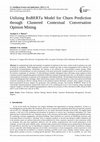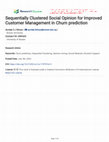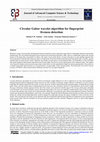Papers by Olufade F . W . ONIFADE

International journal of intelligent systems and applications, Dec 7, 2023
In computational study and automatic recognition of opinions in free texts, certain words in sent... more In computational study and automatic recognition of opinions in free texts, certain words in sentences are used to decide its sentiments. While analysing each customer's opinion per time in churn management will be effective for personalised recommendations. Oftentimes, the opinion is not sufficient for contextualised content mining. While personalised recommendations are time consuming, it also does not provide complete picture of an overall sentiment in the business community of customers. To help businesses identify widespread issues affecting a large segment of their customers towards engendering patterns and trends of different customer churn behaviour, here, we developed a clustered contextualised conversation as opinions set for integration with Roberta Model. The developed churn behavioural opinion clusters disambiguated short messages while charactering contents collectively based on context beyond keyword-based sentiment matching for effective mining. Based on the predicted opinion threshold, customer churn category for groupbased personalised decision support was generated, with matching concepts. The baseline RoBERTa model on the contextually clustered opinions, trained with a batch size of 16, a learning rate of 2e-5, over 8 epochs, using a maximum sequence length of 128 and standard hyperparameters, achieved an accuracy of 92%, Precision of 88%, Recall of 86% and F1 score of 84% over a test set of 30%.
Lecture notes on data engineering and communications technologies, Dec 31, 2022
Lecture notes in networks and systems, 2024

Lecture Notes of the Institute for Computer Sciences, Social Informatics and Telecommunications Engineering, 2018
Cloud adoption for Internet of Things is gaining attention among researchers and organizations. T... more Cloud adoption for Internet of Things is gaining attention among researchers and organizations. The decision to choose a Cloud vendor is complicated and dynamic in nature. The majority of the existing Decision support systems designed to support migration to the Cloud have limitations. They mostly provide information to support evaluation and selection of vendors with cost being the main factor while some fundamental issues had been left unsupported. This work proposes a robust User-Centric Cloud of Things Decision Analytic Model using Ellipsoidal Fuzzy Inference System. The proposed model supports real time decision making process for the adoption of Cloud computing in Internet of Things by comparing User-defined Application demand and Cloud Decision attributes. The results of this work are expected to contribute to the acceptance of Cloud of Things services.

La subjectivite des estimations et des perceptions, la complexite de l’environnement, l’interacti... more La subjectivite des estimations et des perceptions, la complexite de l’environnement, l’interaction entre sous-systemes, le manque de donnees precises, les donnees manquantes, une faible capacite de traitement de l’information, et l’ambiguite du langage naturel representent les principales formes d’incertitude auxquelles les decideurs doivent faire face lorsqu’ils prennent des decisions strategiques a l’aide de systemes d’intelligence economique. Cette etude utilise un paradigme de « soft computing » pour identifier et analyser l’incertitude, que nous associons a la notion de facteurs de risque d’information. Pour cela, nous proposons un modele de rapprochement exploitant des ontologies, ainsi qu’un modele baptise « FuzzyWatch » fonde sur la logique floue. Nous avons modelise le processus de prise de decision depuis la definition du probleme jusqu’a la reponse a la question : « est-il raisonnable de decider ? ». Un diagramme causal d’Ishikawa permet de prendre en compte les facteurs intangibles dans cette approche. Le cadre de reference du rapprochement de connaissances a ete prevu pour faciliter le partage et la reutilisation de connaissances entre les utilisateurs et la machine. En complement, les facteurs intangibles, les emotions, les ambiguites du langage naturel sont pris en compte a l’aide de fonctions d’appartenance floues. Les outils de la logique floue ont ete egalement utilises au niveau des ontologies (« FuzzOntology »). Au niveau du processus de recherche d’information, l’introduction d’une fonction de mise en correspondance floue, appelee « FuzzyMatch », ameliore le taux de rappel et subsequemment le processus d’intelligence economique. Le modele « Fuzzontologique » autorise une prise en compte flexible de facteurs intangibles et incertains, offrant ainsi un moyen de traiter l’ambiguite du langage naturel. FuzzyMatch permet de reduire les problemes de donnees manquantes. A l’aide de ces modeles, le processus de decision en intelligence economique beneficie d’une reduction des risques lies a l’information lors du processus de recherche.
Lecture notes in networks and systems, 2023
With Twitter ranking as one of the fastest growing social media platform, it represents a means v... more With Twitter ranking as one of the fastest growing social media platform, it represents a means via which simultaneous sharing of opinion is made possible. This huge resources for information is however limited in its ability to present human readers and opinion seekers relevant information tailored towards experience, ability to extract, read, summarize and finally organize them in appropriately usable forms. The volume of available tweets is not actually the problem, but the nature of the data which harbors a lot of sentiment. This paper is set to present improved means of accurately providing analysis of automatically retrieved opinions and presenting the results to the user after performing sentiment analysis on the retrieved data.

International Journal of Mathematical Sciences and Computing, Feb 8, 2023
Among other factors affecting face recognition and verification, the aging of individuals is a pa... more Among other factors affecting face recognition and verification, the aging of individuals is a particularly challenging one. Unlike other factors such as pose, expression, and illumination, aging is uncontrollable, personalized, and takes place throughout human life. Thus, while the effects of factors such as head pose, illumination, and facial expression on face recognition can be minimized by using images from controlled environments, the effect of aging cannot be so controlled. This work exploits the personalized nature of aging to reduce the effect of aging on face recognition so that an individual can be correctly recognized across his/her different age-separated face images. To achieve this, an individualized face pairing method was developed in this work to pair faces against entire sets of faces grouped by individuals then, similarity score vectors are obtained for both matching and non-matching image-individual pairs, and the vectors are then used for age-invariant face recognition. This model has the advantage of being able to capture all possible face matchings (intra-class and inter-class) within a face dataset without having to compute all possible image-to-image pairs. This reduces the computational demand of the model without compromising the impact of the ageing factor on the identity of the human face. The developed model was evaluated on the publicly available FG-NET dataset, two subsets of the CACD dataset, and a locally obtained FAGE dataset using leave-one-person (LOPO) cross-validation. The model achieved recognition accuracies of 97.01%, 99.89%, 99.92%, and 99.53% respectively. The developed model can be used to improve face recognition models by making them robust to agevariations in individuals in the dataset.
With the proliferation of multimedia data such as images, audio, and video, robust digital waterm... more With the proliferation of multimedia data such as images, audio, and video, robust digital watermarking and data hiding techniques are needed for copyright protection, copy control, annotation, and authentication. While many techniques have been proposed for digital color and grayscale images, not all of them can be directly applied to binary document images. The difficulty lies in the fact that changing pixel values in a binary document could introduce Irregularities that is very visually noticeable. We have seen but limited number of papers proposing new techniques and ideas for document image watermarking and data hiding. In this paper, we present an overview and summary of recent developments on this important topic, and discuss important issues such as robustness and data hiding capacity of the different techniques.

Lecture Notes in Computer Science, 2018
Cloud adoption for Internet of Things is gaining attention among researchers and organizations. T... more Cloud adoption for Internet of Things is gaining attention among researchers and organizations. The decision to choose a Cloud vendor is complicated and dynamic in nature. The majority of the existing Decision support systems designed to support migration to the Cloud have limitations. They mostly provide information to support evaluation and selection of vendors with cost being the main factor while some fundamental issues had been left unsupported. This work proposes a robust User-Centric Cloud of Things Decision Analytic Model using Ellipsoidal Fuzzy Inference System. The proposed model supports real time decision making process for the adoption of Cloud computing in Internet of Things by comparing User-defined Application demand and Cloud Decision attributes. The results of this work are expected to contribute to the acceptance of Cloud of Things services.
In this paper, we derive a simple and accurate Erlang-like model for GSM congestion control takin... more In this paper, we derive a simple and accurate Erlang-like model for GSM congestion control taking into account SDCCH (Standalone Dedicated Control Channel) dimensioning and reattempt phenomenon. Increased number of active calls and reduction in call drops using the reattempt queuing model will mitigate the congestion level in the SDCCH Channel. Also a two dimensional Markov chain for the proposed model is presented. Keywords : Erlang-B, GSM, networks, congestion, SDCCH, reattempt phenomenon

La subjectivite des estimations et des perceptions, la complexite de l’environnement, l’interacti... more La subjectivite des estimations et des perceptions, la complexite de l’environnement, l’interaction entre sous-systemes, le manque de donnees precises, les donnees manquantes, une faible capacite de traitement de l’information, et l’ambiguite du langage naturel representent les principales formes d’incertitude auxquelles les decideurs doivent faire face lorsqu’ils prennent des decisions strategiques a l’aide de systemes d’intelligence economique. Cette etude utilise un paradigme de « soft computing » pour identifier et analyser l’incertitude, que nous associons a la notion de facteurs de risque d’information. Pour cela, nous proposons un modele de rapprochement exploitant des ontologies, ainsi qu’un modele baptise « FuzzyWatch » fonde sur la logique floue. Nous avons modelise le processus de prise de decision depuis la definition du probleme jusqu’a la reponse a la question : « est-il raisonnable de decider ? ». Un diagramme causal d’Ishikawa permet de prendre en compte les facteurs...

International Journal on Data Science and Technology, 2020
The adoption of product centric approach to customer acquisition by many subscriber based compani... more The adoption of product centric approach to customer acquisition by many subscriber based companies has become a factor, which influences customer misclassification in existing churn predictive models. While the transaction volume, velocity, and varieties for basic churn processes continues to increase exponentially, every customer remained a potential churner to a certain degree. Although, existing churn prediction models classifies customers as churner or nonchurner, many of its approaches assign equal weight to features while the customer's power of influence from sociotransactional data mining are neglected in churn behaviour management. Here, the developed Churn Predictive System is a composite of Recency-Frequency-Monetary-Influence model through customer segmentation management and Fuzzy-Weighed Feature Engineering model, which trained and tested transactional records using Random Forest and Adaboost Ensemble Learning in a 5-fold cross validation protocol. This System was coupled (Customer Segmentation + Ensemble Learning) to achieve a quadrupled customer's churn category as Churner, Potential Churner, Inertia Customer and Premium Customers. The results from the developed system juxtapose the need for a new approach to churn prediction in customer behavioural management.
2015 2nd World Symposium on Web Applications and Networking (WSWAN), 2015
With Twitter ranking as one of the fastest growing social media platform, it represents a means v... more With Twitter ranking as one of the fastest growing social media platform, it represents a means via which simultaneous sharing of opinion is made possible. This huge resources for information is however limited in its ability to present human readers and opinion seekers relevant information tailored towards experience, ability to extract, read, summarize and finally organize them in appropriately usable forms. The volume of available tweets is not actually the problem, but the nature of the data which harbors a lot of sentiment. This paper is set to present improved means of accurately providing analysis of automatically retrieved opinions and presenting the results to the user after performing sentiment analysis on the retrieved data.

International Journal of Advances in Applied Sciences
Through the hype in digital marketing and the continuous increase in volume and velocity of opini... more Through the hype in digital marketing and the continuous increase in volume and velocity of opinions about an organization’s brands, churn prediction now requires advanced analytics in opinion mining for effective customer behavioral management beyond keywords sentiment analysis (SA). Earlier, by analyzing customers’ opinions using SA models, the extracted positive-negative polarity is used to classify customers as churners or non-churner. In those methods, the impact of word order, context, and the inherent semantics of the clustered opinion set were oftentimes overlooked. However, with the consistent creation of new words with new meanings mapped to existing words on the web, the research extended the fuzzy support vector model (FSVM) to show that the dependency distance between the headword, its dependent, and tail word can be weighted by using information content derived from a corpus to generate four-classed social opinion categories as a strongly positive, positive, negative, ...

2019 15th International Conference on Electronics, Computer and Computation (ICECCO), 2019
Facial age estimation has increasingly gained attention in the Computer Vision and Image Processi... more Facial age estimation has increasingly gained attention in the Computer Vision and Image Processing research community due to its numerous applications in several domains. Thus, research efforts are still on to improve facial age estimation accuracy. One of the ways to improve facial age estimation is to strengthen the associated preprocessing stages, two of which are face detection and face alignment. In this paper, a computational method of aligning the face prior to facial age estimation is proposed. Without any form of learning, the proposed face alignment method uses trigonometric and set operations to align a given facial image and to enhance the face detection process prior to age estimation. The impact of the proposed face alignment method on facial age estimation was evaluated via experiments on two publicly available facial ageing datasets FG-NET and Lifespan datasets.

IOSR Journal of Computer Engineering, 2017
In this information age, searching for information from the internet becomes wide spread, but som... more In this information age, searching for information from the internet becomes wide spread, but some of the valuable information are hidden behind dynamically generated page which the search engines never crawled. It becomes imperative to find a way of making them available. This research work provides a scalable framework for locating forms that serves as the entry point for information in web databases. The methodology focuses on the link classifier by using Path-Ascending algorithm which has the advantage of searching as many resources as possible from a particular site, since forms are sparsely distributed, After implementing this framework, it was observed that the framework searches more than 90% of the links in each site tested which is comparatively higher than using search algorithm in the link classifier. This framework suggest using path ascending algorithm in the link classifier which make the crawler to search almost all the links on each page of a site providing a better opportunity to locate a searchable form. Crawler: a program that systematically browse the world wide web in order to create an index of data, deep web: information buried far down on dynamically generated sites, and standard search engines never find it, Frontier:it consist of URL and Crawling modules used to crawl the web pages to extract the meta data,surface web: information that common search engines like Google, Yahoo, AltaVista, Ask, and Bing can crawl.

As business competition continues to increase in different sectors of the economy, chum predictio... more As business competition continues to increase in different sectors of the economy, chum prediction models as a social behaviour have continued to impact the classification of customers for enhanced decision support and recommendations through text analytics. While it is generally believed that user’s opinion can be gradually influenced by friends on the social media, the prospect of a churning customer increases proportionately when the friend churns. However, oftentimes, during media exchange on the social network, customers are treated distinctly for positive, negative and neutral opinion classifications. By this, the network structure, sequential conversion and its influence on the user community content is neglected for churn prediction. Thus, by developing an opinion-based churn prediction model through sequential content clustering, this research explores user’s media conversation to understand the intrinsic mechanisms of sequentially formulated opinion in a social network com...

Journal of Advanced Computer Science & Technology, 2020
Biometrics usage is growing daily and fingerprint-based recognition system is among the most effe... more Biometrics usage is growing daily and fingerprint-based recognition system is among the most effective and popular methods of personality identification. The conventional fingerprint sensor functions on total internal reflectance (TIR), which is a method that captures the external features of the finger that is presented to it. Hence, this opens it up to spoof attacks. Liveness detection is an anti-spoofing approach that has the potentials to identify physiological features in fingerprints. It has been demonstrated that spoof fingerprint made of gelatin, gummy and play-doh can easily deceive sensor. Therefore, the security of such sensor is not guaranteed. Here, we established a secure and robust fake-spoof fingerprint identification algorithm using Circular Gabor Wavelet for texture segmentation of the captured images. The samples were exposed to feature extraction processing using circular Gabor wavelet algorithm developed for texture segmentations. The result was evaluated using ...











Uploads
Papers by Olufade F . W . ONIFADE